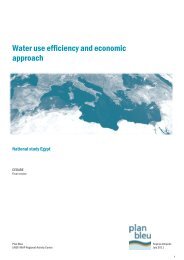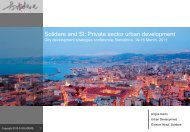Dr. Diane Nauffal - Director of Institutional Research and ... - CMI
Dr. Diane Nauffal - Director of Institutional Research and ... - CMI
Dr. Diane Nauffal - Director of Institutional Research and ... - CMI
Create successful ePaper yourself
Turn your PDF publications into a flip-book with our unique Google optimized e-Paper software.
Benchmarking <strong>and</strong> Implications for<br />
Universities: In depth Look Inside<br />
Universities
What does benchmarking involve?<br />
Why use benchmarking?<br />
The purpose <strong>of</strong> benchmarking<br />
The benchmarking cycle<br />
Challenges <strong>of</strong> benchmarking<br />
A successful benchmarking environment<br />
Lebanese American University (LAU) – Overview<br />
Benchmarking Activities at LAU
Benchmarking involves first examining <strong>and</strong> underst<strong>and</strong>ing an institutions<br />
internal work procedures, then searching for best practices in other<br />
institutions that match those identified, <strong>and</strong> finally, adapting those<br />
practices within the institution to improve performance.<br />
Benchmarking requires that an institution go through a thorough selfanalysis:<br />
• to develop an in depth underst<strong>and</strong>ing <strong>of</strong> its own processes,<br />
• to recognize its strengths <strong>and</strong> its weaknesses,<br />
• to identify internal <strong>and</strong> external reference points,<br />
• to look at other institutions for examples <strong>of</strong> how to do things more<br />
efficiently <strong>and</strong> effectively to better overcome its weaknesses <strong>and</strong> to<br />
ensure the sustainability <strong>of</strong> its strengths at even higher levels <strong>of</strong><br />
performance.
Benchmarking is being used to improve administrative processes as<br />
well as instructional models <strong>of</strong> institutions <strong>of</strong> higher education<br />
(Chaffee & Sherr 1992; Alstete 1997).<br />
The importance <strong>of</strong> benchmarking as an improvement strategy lies<br />
in that it provides an external focus on internal activities,<br />
functions <strong>and</strong> processes (Kempner 1993).<br />
By integrating benchmarking into the fundamental operations <strong>of</strong><br />
an institution it transforms an institution into a true learning<br />
organization.<br />
Benchmarking will be most useful to those organizations that have<br />
made a commitment to redesign their processes.
Benchmarking is an ongoing systematic process that involves finding,<br />
adapting <strong>and</strong> implementing outst<strong>and</strong>ing practices for the purpose <strong>of</strong><br />
achieving higher st<strong>and</strong>ards <strong>of</strong> excellence <strong>and</strong> continuous improvement.<br />
Benchmarking<br />
• contributes to accountability,<br />
• contributes to quality management,<br />
• focuses on demonstrated best practices,<br />
• provides a tool for learning,<br />
• provides a basis for research for improving practices,<br />
• allows for better underst<strong>and</strong>ing <strong>of</strong> operational practices,<br />
• stimulates the need for change,<br />
• provides a roadmap for action, <strong>and</strong><br />
• provides opportunities <strong>of</strong> networking through collaborative efforts<br />
(Epper, 1999).
Adaptation <strong>of</strong><br />
enablers for<br />
improvement<br />
Determine<br />
process<br />
enablers <strong>of</strong><br />
high<br />
performance<br />
Plan the<br />
study<br />
Determine<br />
gaps in<br />
performance<br />
Collect<br />
data<br />
Analyze data
Defining best practices <strong>and</strong> core competences.<br />
Readily applicable to administrative processes, less so to processes<br />
related to teaching <strong>and</strong> learning.<br />
<strong>Institutional</strong> readiness for benchmarking. Level <strong>of</strong> awareness <strong>of</strong><br />
internal processes.<br />
Level <strong>of</strong> incentive to commit to the benchmarking exercise or to<br />
the implementation <strong>of</strong> results.<br />
Is the institution <strong>and</strong> its leadership ready to act on results <strong>and</strong><br />
commit to implement change for the purpose <strong>of</strong> improvement or<br />
does the institution see benchmarking as an exploratory study?<br />
Benchmarking requires sufficient resources. It can be time<br />
consuming <strong>and</strong> costly.
Leadership<br />
with Vision<br />
Competitive<br />
Environment<br />
Innovation<br />
<strong>and</strong> Quality<br />
Improvement<br />
Stakeholder<br />
Buy In<br />
Guided by Knowledge <strong>and</strong> Information<br />
Strategic <strong>and</strong><br />
Operational<br />
Planning<br />
Excellence<br />
<strong>and</strong><br />
Sustainability
Founded as a women’s college in 1924, the Lebanese American University is a<br />
not-for-pr<strong>of</strong>it private institution <strong>of</strong> higher education in Lebanon rooted in the<br />
tradition <strong>of</strong> exemplary education.<br />
LAU has a campus in Beirut, Lebanon’s capital <strong>and</strong> largest population hub, <strong>and</strong><br />
another about 35 kilometers to the north, in Byblos.<br />
The two campuses together house seven schools. The schools common to both<br />
campuses are: Architecture <strong>and</strong> Design, Arts <strong>and</strong> Sciences <strong>and</strong> Business. The<br />
Byblos campus is home to the School <strong>of</strong> Engineering, Medicine, Nursing <strong>and</strong><br />
Pharmacy.<br />
Student enrollments were 8,138 in 2012 with 7,457 undergraduates, 509<br />
graduates <strong>and</strong> 172 doctoral degree-pr<strong>of</strong>essional practice.<br />
There are 299 full-time faculty, 123 are dual nationals while 49 are non-<br />
Lebanese. There are 557 full-time staff.<br />
LAU was granted accreditation by the Commission on Institutions <strong>of</strong> Higher<br />
Education <strong>of</strong> the New Engl<strong>and</strong> Association <strong>of</strong> Schools <strong>and</strong> Colleges (CIHE–<br />
NEASC).
The Doctor <strong>of</strong> Pharmacy program is fully accredited by the Accreditation Council<br />
for Pharmacy Education (ACPE). This status allows LAU Pharm.D. graduates to sit<br />
for the North American Pharmacy Licensure Examination (NAPLEX), <strong>and</strong> practice in<br />
most U.S. states. ACPE first accredited the program in 2002. LAU’s Pharm.D. is the<br />
only ACPE-accredited program outside the United States.<br />
On October 1, 2011 the Accreditation Board for Engineering <strong>and</strong> Technology (ABET)<br />
granted accreditation to all five undergraduate degree programs in the School <strong>of</strong><br />
Engineering - Civil, Computer, Electrical, Industrial, <strong>and</strong> Mechanical. This<br />
accreditation action extends retroactively from October 1, 2009.<br />
On October 1, 2011 the Bachelor <strong>of</strong> Science degree program in computer science<br />
was formally accredited by the Computing Accreditation Commission <strong>of</strong> the<br />
Accreditation Board for Engineering <strong>and</strong> Technology (ABET). This accreditation<br />
action extends retroactively from October 1, 2010.<br />
Accreditation may be considered a form <strong>of</strong> benchmarking activity.
The National Survey for Student Engagement (NSSE) probes the level<br />
<strong>of</strong> engagement <strong>of</strong> first year <strong>and</strong> senior students in several university<br />
activities. These activities include academic <strong>and</strong> intellectual<br />
experiences, mental activities, reading <strong>and</strong> writing, problem sets,<br />
examinations, enriching educational experiences, quality<br />
relationships, time usage, institutional environment, educational<br />
<strong>and</strong> personal growth, <strong>and</strong> others (NSSE, 2011).<br />
The NSSE also provides benchmark scores based on effective<br />
educational best practices in five areas: (1) level <strong>of</strong> academic<br />
Challenge – LAC; (2) active <strong>and</strong> collaborative learning – ACL; (3)<br />
student-faculty interaction – SFI; (4) enriching educational<br />
experiences – EEE; <strong>and</strong> (5) supportive campus environment – SCE.<br />
Students’ perceptions <strong>of</strong> the level <strong>of</strong> their engagement at LAU are<br />
benchmarked against three peer groups.
Level <strong>of</strong> Academic Challenge (LAC)<br />
Academic<br />
Year<br />
First Year Students Senior Students<br />
LAU Carnegie Peers All NSSE Peers<br />
Mean Mean Sig Effect size Mean Sig Effect size<br />
2006 51.4 52.4 53.6 *** -‐0.17<br />
2007 50.5 55.1 *** -‐0.37 52.8 ** -‐0.18<br />
2008 53.8 52.5 0.09 53.9 -‐0.01<br />
2009 54.7 54.3 0.03 54.3 0.03<br />
2010 53.6 54.3 -‐0.05 54.6 -‐0.07<br />
2011 53.4 54 -‐0.05 53.8 -‐0.03<br />
Academic<br />
Year<br />
LAU Carnegie Peers All NSSE Peers<br />
Mean Mean Sig Effect size Mean Sig Effect size<br />
2006 57.0 56.4 57.4<br />
2007 56.5 57.3 -‐0.06 56.4 0.01<br />
2008 59.3 57.3 0.15 57.5 0.13<br />
2009 59.5 56.1 ** 0.24 57.8 0.12<br />
2010 59.5 58.3 0.09 58.1 0.10<br />
2011 57.7 58.2 -‐0.04 57.6 0.00<br />
Office <strong>of</strong> <strong>Institutional</strong> <strong>Research</strong> <strong>and</strong> Assessment
A benchmark study on human resources in three institutions in the<br />
region; AUB, AUC <strong>and</strong> LAU. This project was spearheaded by LAU.<br />
Reasons for the Benchmarking project<br />
• Leadership committed to make LAU a world class employer <strong>and</strong><br />
an employer <strong>of</strong> choice. This was translated into action steps in<br />
the institutional strategic plan.<br />
• Competition among institutions to attract <strong>and</strong> retain good<br />
faculty. Indicators considered were salary, benefits, workloads<br />
<strong>and</strong> others.<br />
• Comparison <strong>of</strong> productivity <strong>and</strong> efficient use <strong>of</strong> resources.<br />
• Benchmarking with the US seemed futile in this case.
• Kempner, D.E. (1993). The Pilot Years: The growth <strong>of</strong> the NACUBO<br />
Benchmarking Project. NACUBO Business Officer, 27(6), 21-31.<br />
• Chaffee, E.E. <strong>and</strong> Sherr, L.A. (1992). Quality: Transforming<br />
Postsecondary Education, George Washington University: Washington.<br />
• Alstete, J. (1997). Benchmarking in Higher Education: Adapting Best<br />
Practices To Improve Quality. Eric Digest.<br />
• Epper, R.M. (1999). Applying Benchmarking to Higher Education: Some<br />
Lessons from Experience, Change, 31(6), 24-31.<br />
• National Survey <strong>of</strong> Student Engagement .(2011). <strong>Institutional</strong> Report.<br />
Indiana University <strong>Research</strong>, Postsecondary <strong>Research</strong>: Bloomington.


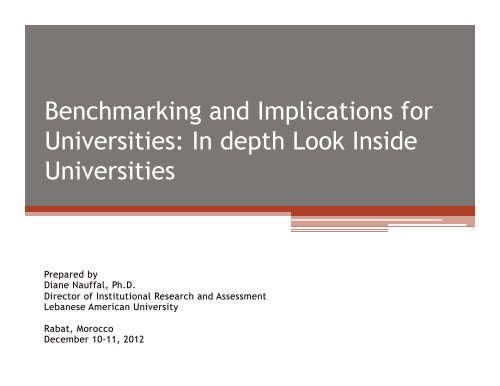



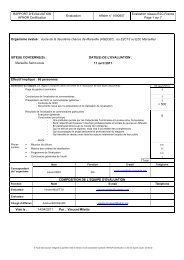
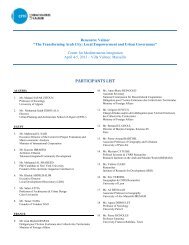

![5-Afif Mehri-SDU [Compatibility Mode] - CMI](https://img.yumpu.com/18242985/1/190x146/5-afif-mehri-sdu-compatibility-mode-cmi.jpg?quality=85)

